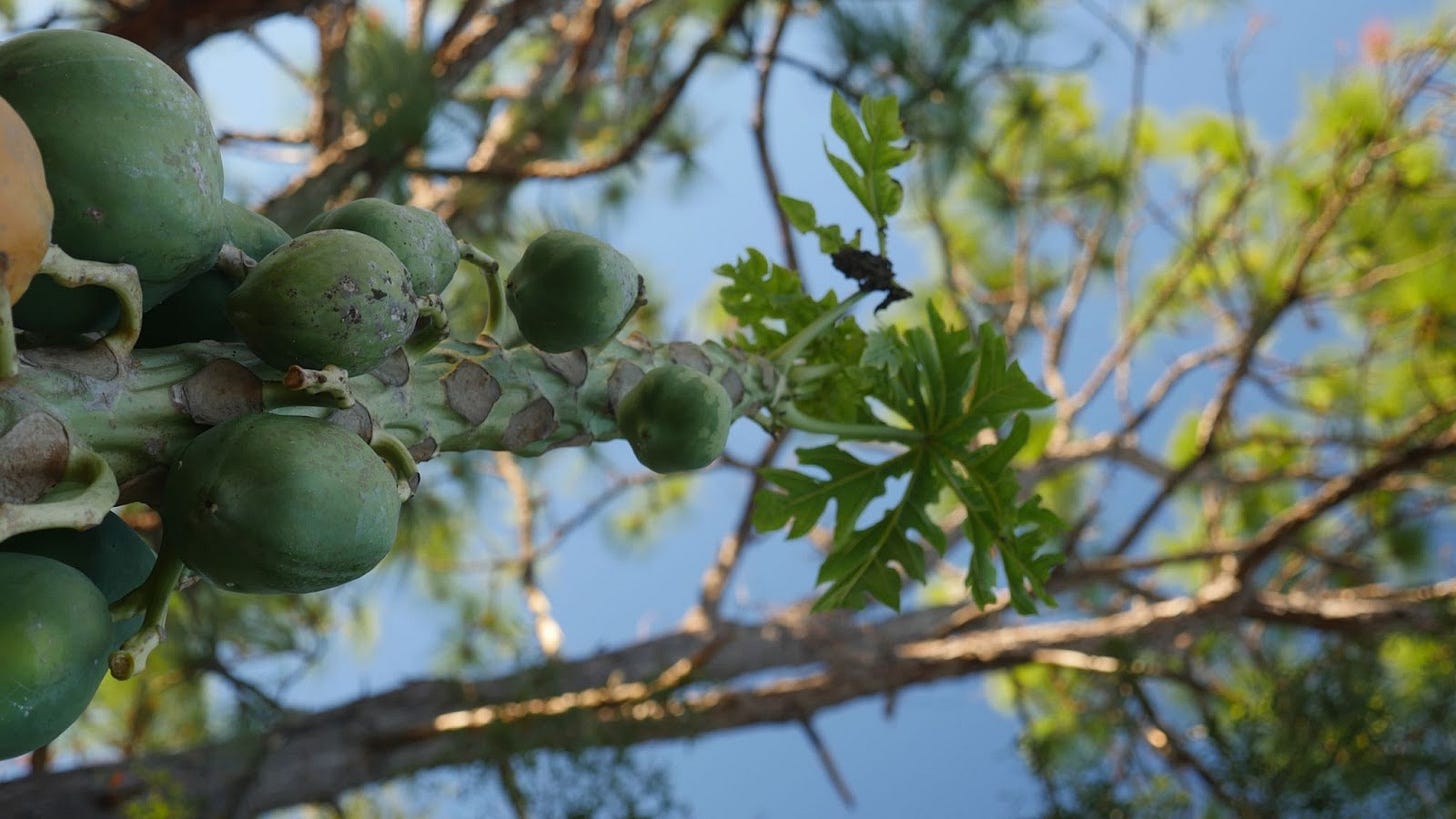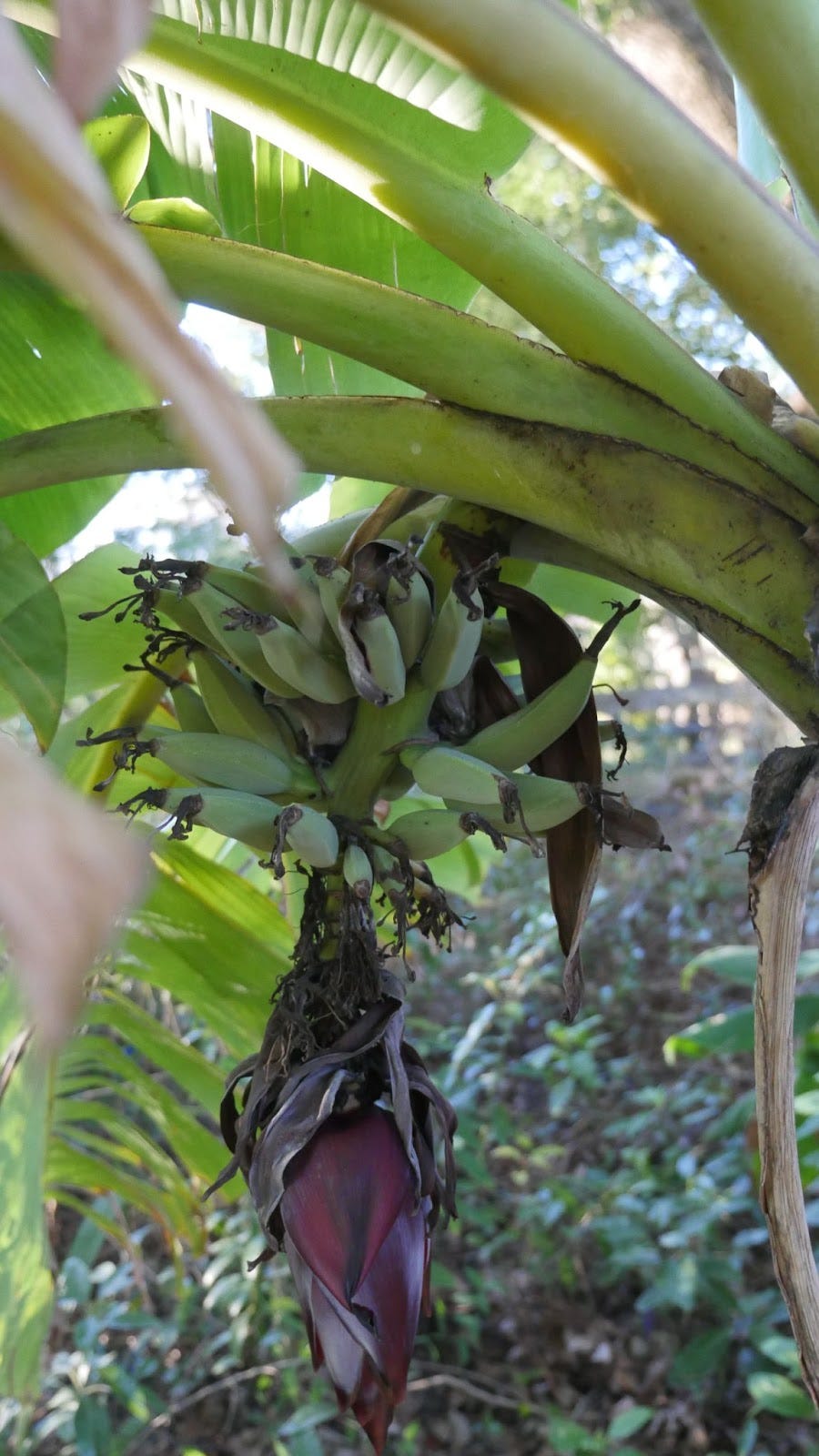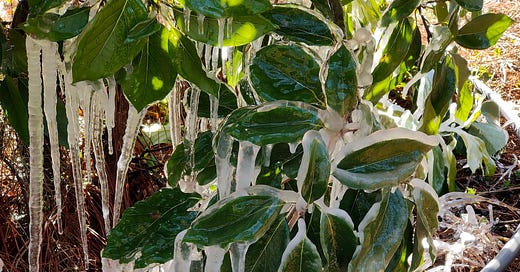How to protect your tropical plants from freezes
We’ve had a few freezes in parts of Central/North Florida so far this year and it looks like we’re going to have more. So we’re sharing our successes with protecting plants from freezes.
This colder weather may be due to record warmth in the Arctic this year. Strangely enough, elevated temperatures in the Arctic push the polar vortex (the very cold air that usually circulates the Arctic) further south in sometimes random or feathery patterns, where it can be shoved into places it usually doesn’t go - like Florida

The Polar Vortex can be destabilized by normal movements of warmth and cold on the planet. The US has cold spells every year because of it. When there is record warmth at the pole, this can cause even more dramatic cold in parts of the US.

Freezes so far have been mild at our farm near Brooksville. Most of our papaya are still standing and we have had only mild dieback of bananas. But the damage can be much worse if it gets even a few degrees colder. In more severe freezes these plants will die to the ground.


There are a few different categories of tropical plants; they have widely varying tolerance to freezes. “True” tropicals, as I call them, can’t tolerate freezing temperatures at all for the most part. They don’t even like to get below 45-50F. Examples of these are cacao, durian and breadfruit.
Other tropicals can survive brief forays of 28-29F without a lot of damage once established. These include mango, jackfruit, lychee, longan, starfruit, papaya, many avocados and others. Lime, guava, some avocados, some citrus and others may be able to survive in temperatures as low as 25F.
There are some subtropical fruits that can survive below 25F. These are usually special cultivars, like Mexican-type avocados, some of which have survived 18F or possibly colder, or Satsuma Mandarins.
There are anecdotal reports of some tropicals surviving far colder weather than they are given credit for. Often, they were in a protected microclimate or the freeze was very brief.
Some tips
Because we are in 9A we experience freezes almost every winter, so we have some strategies to share. There are other approaches, this is just what we use.
If it's going to get below 26F, (could be higher for some tropicals) and especially if it stays that way for hours and repeats over several nights, it will toast most tropicals. This can happen even if they are covered, though that depends on:
a. how cold it gets
b. how long it stays cold
c. how young vs how established the tree is
d. how sensitive the cultivar/type of tree is
e. temperature before the freeze (lower temps can "harden" the tree - high temps make it more vulnerable)
f. if there is wind and how hard it is blowing
That’s a lot of variables! And this is something to remember about protecting from a freeze: you can only do so much if you’re growing things that don’t normally take the periodic freezes you’ve had in your region. If those freezes happened once, they can happen again. So sometimes, you just have to be a bit philosophical about it - detachment can be a helpful viewpoint if an Act of God knocks out some of your plants! In that case, what can you learn? How can you creatively respond to the situation? One thing we’ve done is to focus on planting fruit trees that can take the heat, cold, drought and rainy extremes we get here in Florida. For instance, our dwarf mulberries are stars when it comes to tolerating extreme conditions.
Different cultivars of avocado, citrus, etc, have widely varying frost tolerance. We’ll share more specifics about those varieties in future newsletters.
What you can do
There are two main ways to keep plants alive if they're more delicate tropicals exposed to below freezing temperatures, especially for extended periods (which can freeze even the trunk).
1. Cover them and if needed, provide a heat source like warmed water. Some use a 5 gallon bucket with hot water (may have to be replaced at 3 AM or so depending on how cold and for how long). Or a 55 gallon covered drum with water heated by the sun. Set the drum right by the stem of young, vulnerable trees like mango or avocado, expose it to sunlight, cover the barrel and the tree at night. This has worked well to protect young trees especially.
Be careful with heat lamps. I have faced them toward a bucket of water rather than on the plant itself. Smaller incandescent string lights wrapped around some insulation on the trunk can protect papaya, which will keep resprouting on the top and fruiting if you keep the trunk from freezing. We prefer methods that don’t use electricity.
We use blankets we got from Goodwill to cover plants, not plastic. If using plastic, don't let it touch the tree; it will cause freeze burn damage where it touches. Army surplus wool blankets are useful. We’ve gotten tomatoes through 25F with leaves and wool blankets.
If possible, insulate the plant with pine straw, grass clippings, leaves, whatever you have lying around, and then cover with a blanket. If it's a young, vulnerable plant we cover it with many inches of this material, a foot or more even. You may get some dieback but much of the plant survives.

2. Sprinklers can work, too. Turn them on before it freezes. In the morning you need to leave sprinklers on until the sun has warmed things enough that ice is clearly melting (temp should be 42-45F). Use microsprinklers that cover the lower part of the tree only. Icicles can form and break branches with their weight on the upper part of the tree. You want to keep the trunk and roots warm and heat will rise, giving some protection to the upper tree.

We've gotten good avocado yields when protecting avocado in full flower from freezes with a low sprinkler. We drilled tiny holes in black tubing and made our own sprinklers running from hoses. It is great for irrigation too, very flexible, can be moved, etc.
The water can freeze and make major icicles. Counterintuitive, right? But it keeps the temperature around 32F and insulates from deeper cold.

Our mature avocados can take freezes - we only use sprinklers when they are in flower as the flowers are more vulnerable.
For a small, young tree, we would opt for a bucket of warm water and blanket.
Sprinklers don’t work as well in freezing winds. If it is windy at night use mulch or a blanket, but secure the blankets/mulch so they don't blow off. We use clamps or rope.
If you have a good sized food forest with lots of tropicals that normally never experience a freeze, I'd probably opt for #2. We don't like to use so much water, and these freezes have actually resulted in sinkholes because large citrus and strawberry farmers use sprinklers as well and it's a vast amount of water being pulled out of the ground all at once. So we mostly have frost tolerant plants and use mulch/blankets or warm water in a bucket instead of sprinklers. We will let our bananas and papayas die to the ground (they come back) - we keep our favorite tropicals in a hoophouse.
3. If you can't do either of the above, mulch heavily around the trunk and out to the drip line. Protect the roots - even if the tree dies back, it will often come back. Water the plant and the mulch - water freezes more slowly than air. And if it is grafted, protect the graft, cover it with moist soil and lots of mulch on top. Otherwise the tree may die. If the sun is shining, we let the sun warm the soil and plant during the day and pile the mulch on around 3-4 PM, when it starts cooling off. That way, you're retaining some warmth in the soil.

Be more prepared for disasters - permaculture style!
We are currently working on a project to create a library of permaculture solutions for more resilience in the face of disasters. If you have any successes or strategies or other information on this topic, please share it with us.
We have started a workgroup on the Permaculture Crossing forum. This is where you can share info, meet like-minded people, get involved with the project or just observe what is going on. You control your access, notifications, etc. Invitation to the forum is here: https://community.pcx.earth/share/cfTUgb_Qvh8jZBOl?utm_source=manual
We will continue to share information on the progress of this in our newsletter, including the launch of the library.
Choosing the Best Veggies for Your Garden: A Simple Guide
Not all vegetables are created equal when it comes to your garden’s success. In this webinar, you’ll learn:
🌿How to choose vegetables that are productive, delicious, and easier to grow.
🌿 Tips for balancing yield, taste, and pest resistance in your planting decisions.
🌿Avoid common mistakes so you can focus on the crops that work best for your garden.
We’ll also recommend some of our favorite varieties for Florida, but they’ll do well in other climates too!🌍
I hope you can join us! Let’s make this world a greener place—one step at a time. 🌸
Grow Permaculture Curriculum and Courses:
Are you ready to take your next step in Permaculture? If so, we’ve got you covered from novice to all-star. Our our courses are under the direct supervision of Koreen Brennan, educator, diplomate, and PINA board member.
Online Permaculture Design Course
The internationally recognized Grow Permaculture Online Permaculture Design Coursecomes with hands-on practical and mentoring. Now more than ever, people have attention on creating more choices and resilience in their lives. We want healthy food, a clean environment, happiness and security for us, our children, and future generations. This course offers practical steps to achieving these things in your own life, regardless of your circumstances. You can get started right away! Sign up now!
In-Person Permaculture Design Course
This is Grow Permaculture’s internationally recognized In-Person Permaculture Design Course. This course will be held in St Petersburg, FL, and at our farm in Brooksville, giving people an opportunity to see permaculture in action on both the farm while also studying in an urban environment. Space is limited sign up today!
Check out our full lineup of Grow Permaculture Courses & Events!
Thanks for reading PermaLife! Subscribe for free to receive new posts and support my work.





